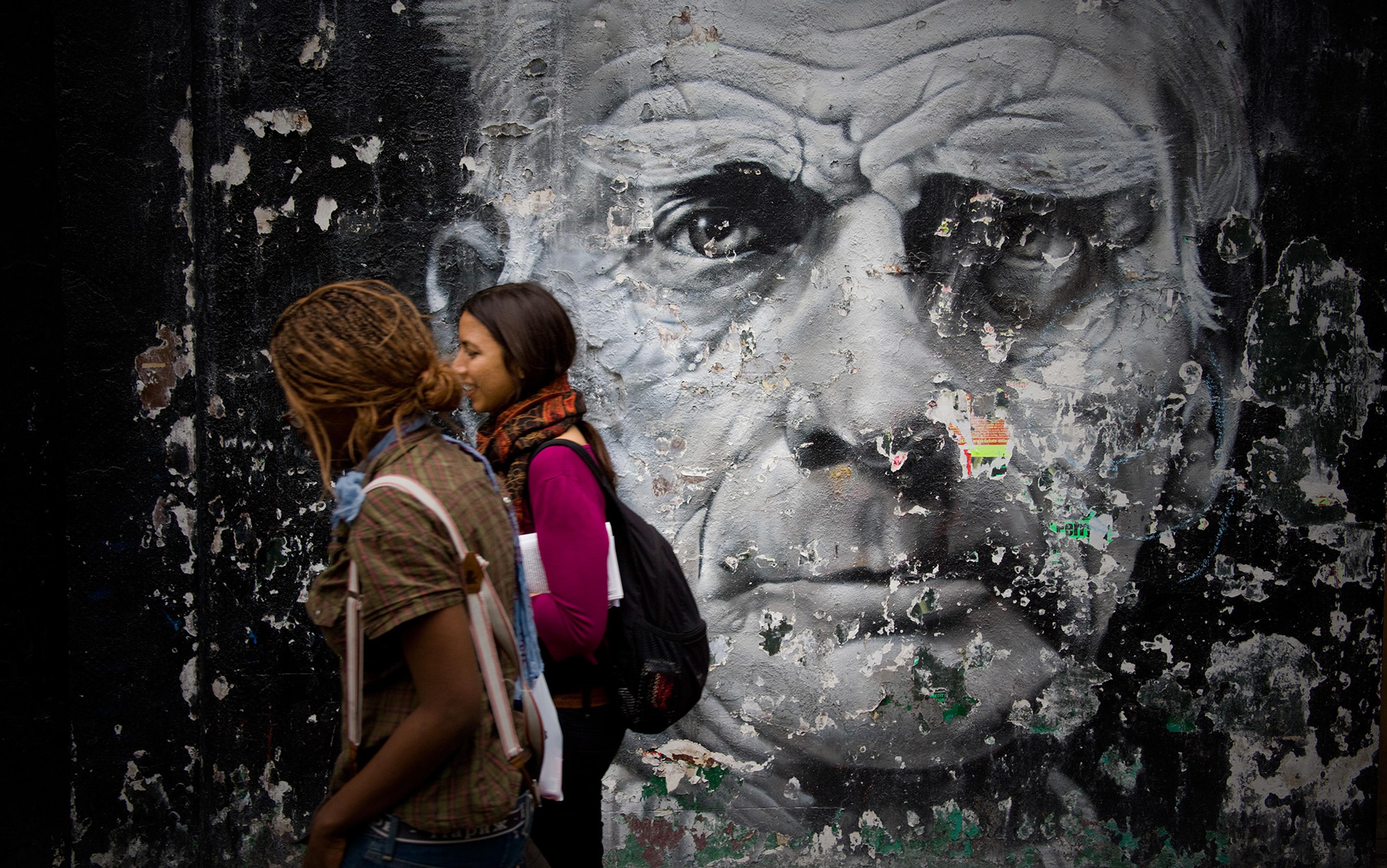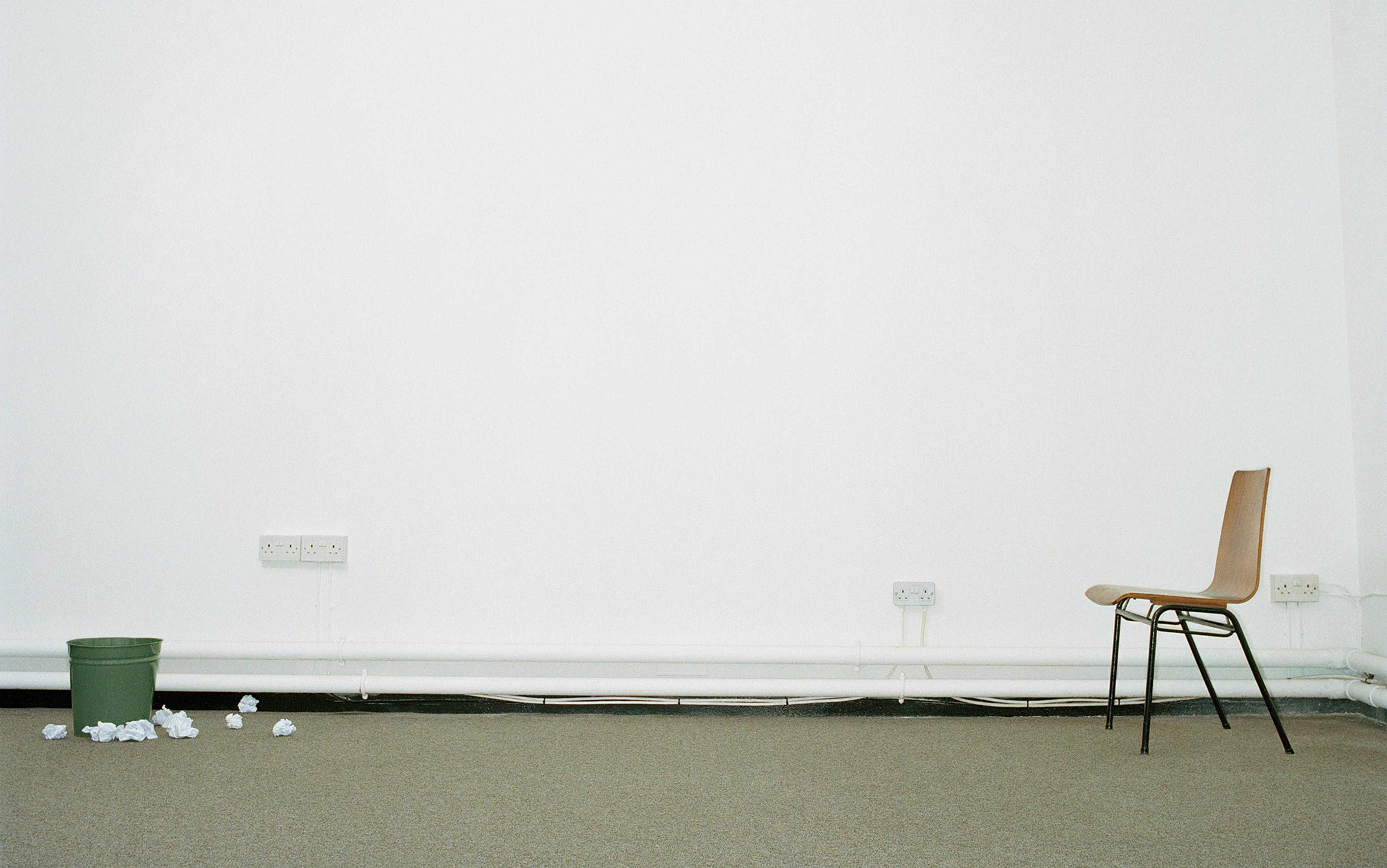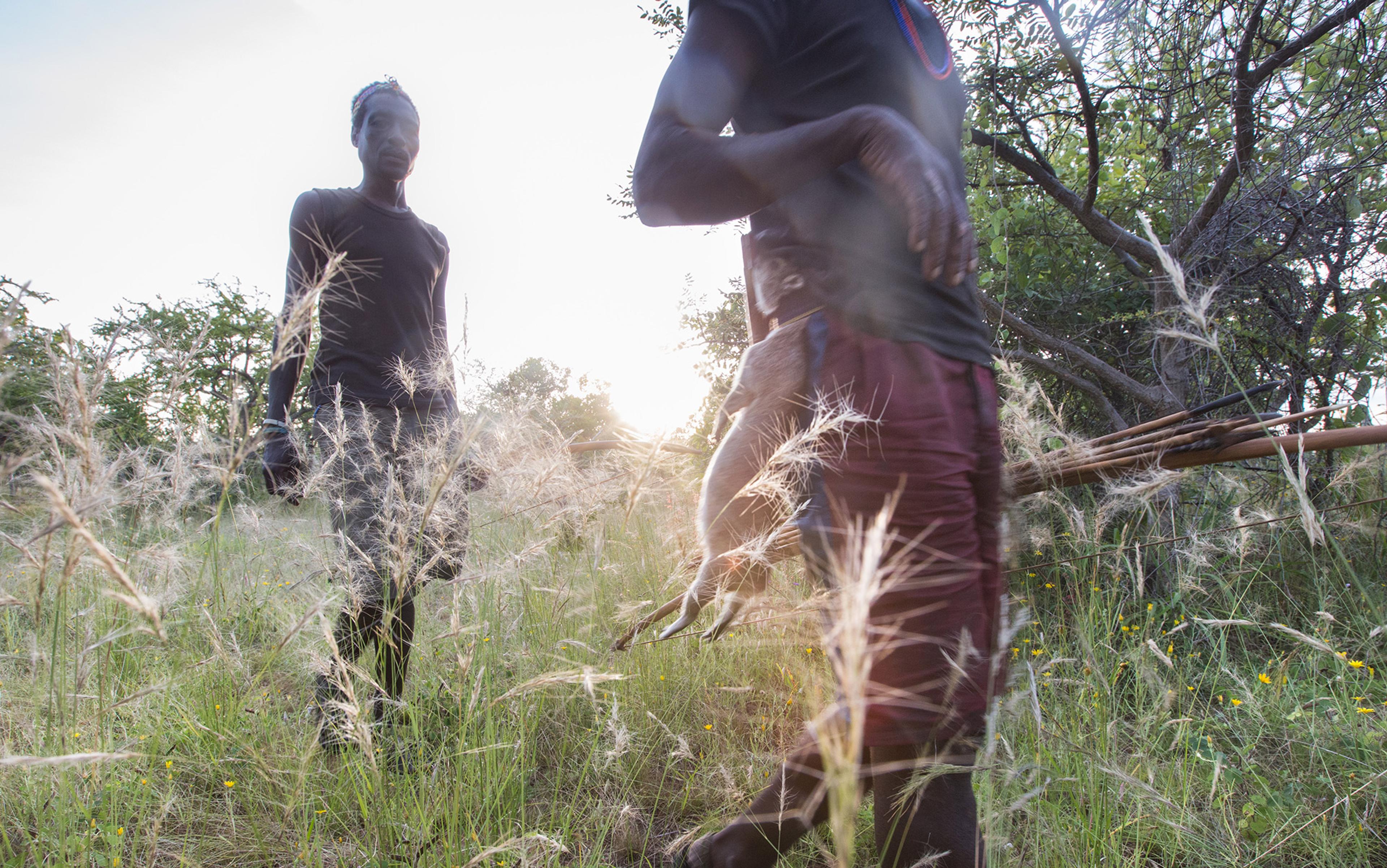In a photographic exhibition titled ‘Removed’ (2015), Eric Pickersgill includes depictions of subjects in the company of other intimates, all of them captured in the act of staring blankly at their hands, where smartphones would normally be placed but have been withdrawn to create images of people alone together. Here is how the artist describes his inspiration for the project:
The work began as I sat in a café one morning. This is what I wrote about my observation: Family sitting next to me at Illium café in Troy, NY is so disconnected from one another. Not much talking. Father and two daughters have their own phones out. Mom doesn’t have one or chooses to leave it put away. She stares out the window, sad and alone in the company of her closest family. Dad looks up every so often to announce some obscure piece of info he found online. Twice he goes on about a large fish that was caught. No one replies. I am saddened by the use of technology for interaction in exchange for not interacting. This has never happened before and I doubt we have scratched the surface of the social impact of this new experience. Mom has her phone out now.
Pickersgill’s work is very much of a piece with broader social and economic concerns over the phenomenon of disengagement in (and from) our culture. Recently, the United States surgeon general issued a public health advisory detailing a growing epidemic of isolation and loneliness, one fuelled largely, though not exclusively, by our increasing use of digital technologies as a substitute for in-person engagement. This trend was taking shape long before the COVID-19 pandemic forced our mass removal from public space and from familiar patterns of shared life, and we are only beginning to understand that era’s long-term effects on our personal and public wellbeing. Meanwhile, the moral and managerial panic over the great resignation, quiet quitting and other (even benign) forms of labour disruption in the wake of the pandemic reveals the extent to which our voluntary practices of leave-taking have been pathologised. We are, it seems, obliged to show up – to be reliably present, available and legible – for our own good or for that of the collective.
Rarely do we display much intellectual curiosity about what these practices of withdrawal might be doing for – not just to – us. Acts of disengagement are routinely met with scepticism, judgment and pushback in public discourse. What if we were to treat them instead as opportunities for open enquiry and ask what is to be gained by them? In that spirit, I propose an expanded lexicon that speaks to the benefits of escaping (even temporarily) the confines of waged work; of disconnecting from the enmeshments of a modern existence; and of seizing interludes for contemplation in a world that is chockablock with demands and distractions.
The early period of the pandemic (which approximated in many respects a kind of general labour strike) gave some of us an intimation of what life lived largely off the clock can be like when much of what passes for work is suspended or slowed and we are afforded precious ‘little gaps of solitude and silence’, as the French philosopher Gilles Deleuze called them, to engage in worthy pursuits that elude us under normal circumstances. We found incomparable personal freedoms and new opportunities for enrichment and fulfilment in the cessation of many of our standard operating procedures.
Then, as everyone recalls, we were summoned back to the office. But, once we had experienced this new way of being, the prospect of returning to the old order – submitting to the control, policing and surveillance of our former workaday lives – became almost unthinkable, especially for members of a chronically insecure workforce forced to endure low pay, lack of opportunity for advancement, inflexible schedules, and a multitude of everyday insults and indignities. Perhaps the chief insult to us all is the governing assumption that we must be collocated – or collated – to do our best work, despite having demonstrated our capacity for self-directed productivity from home (or other private quarters) under the most trying circumstances.
The organisation has a vested interest in cultivating the ties – or tethers – that bind us
Alas, the administrative impulse to fix our fluidity is nearly universal. Remote work is increasingly supervised and surveilled with keylogger software and other technologies to monitor employee time on task. Amazon, Google and Zoom are among a growing list of companies issuing return-to-work orders, ostensibly to capitalise on the sorts of serendipitous face-to-face interactions that might lead to profitable new ideas and innovation but also simply to pay the rent. In the US, recent survey data from the Government Accountability Office show that most federal agencies in GAO’s review recorded average headquarter weekly occupancy rates of 25 per cent or less during the first three months of 2023, prompting cries of concern from industry observers who cannot abide all that unused physical space. Across the globe, underutilised or vacant offices are being tracked with alarm. We belong back at work, we are told, which is another way of saying that we belong to work.
‘Sense of belonging’, in fact, has become a buzzword in human resources offices over the past decade or so. Nearly every setting where work is performed – from the college campus to the corporation – has taken up the rallying cry of cementing an attachment to place. The literature on sense of belonging is clear on the benefits to workers: enhanced performance, motivation and commitment, as well as heightened feelings of safety and security. In many respects, though, the ultimate beneficiary is the organisation itself, which has a vested interest in cultivating the ties – or tethers – that bind us. It is a small step from connectedness to capture, where the sense of belonging is an organisation’s sense that its subjects belong to it.
Those of us who wish to contest our subjection can, of course, unite in coordinated campaigns of resistance and push for formal reforms. We can also embrace quieter, less visible tactics, including the direct action of flight. As Dimitris Papadopoulos, Niamh Stephenson and Vassilis Tsianos argue in their book Escape Routes: Control and Subversion in the 21st Century (2008), ‘escape functions not as a form of exile, nor as mere opposition or protest, but as an interval which interrupts policing.’
In The Scent of Time: A Philosophical Essay on the Art of Lingering (2009), Byung-Chul Han suggests that our experience of intervals is being ‘destroyed in order to produce total proximity and simultaneity’. When everything (and everyone) is within reach at all times, we lose a sense of what it means to be in – and even to savour – transitional states of in-betweenness. As an antidote, Papadopoulos, Stephenson and Tsianos recommend that we ‘tarry with time’ and ‘make spaces for the play of purposeless action’.
We can, in other words, reappropriate some of the time and space being withdrawn from us. These can be reclaimed in the fugitive moments we thieve from the calendar, or they can be recovered in what the anarchist Hakim Bey in 1985 called ‘temporary autonomous zones’: undetectable underground enclaves that we carve out of the landscape of our everyday lives in order to find or free ourselves. Simultaneously, practices of disengagement might withdraw from organisations (workplaces primary among them) their extraordinary power to mediate – to dictate and direct – far too many aspects of our existence and experience. Opting to bypass certain workplace amenities and conveniences expertly designed to keep us at work – the cafeteria, the fitness centre, the dry cleaner, the onsite health clinic – might not seem like much of a tactic of rebellion, but it does its part to lessen our dependence on our employer as lifehack, helpmate or healer.
On one level, disengagement can be understood as an effort to slip apparatuses of control wherever we encounter them. Think of this as a strike for worker empowerment. The bigger question, though, is whether we can ever really escape the toil and trouble for good. It often seems as if we are doomed to sustain the systems and structures that suspend us in cycles of weariness, overwhelm or misery.
It is about engaging in a social policy of degrowth as a corrective to practices that are taxing the planet
Respite is a natural adaptive response to a world that is too much with us, as the Romantic poet William Wordsworth put it, a world that might be improved by less (not fewer) of us in it. When people are exhausted, disengagement provides temporary relief from persistent feelings of overwork and a blessed release from our enervating entanglements. What society cannot countenance, it seems, is prolonged disengagement, which tends to be conflated with civic apathy or indifference.
Seldom do we reckon with the costs of civic engagement or even frame that as a problem unto itself. Yet staying abreast of current events under the guise of doing our civic duty produces not just an informed (and occasionally misinformed or disinformed) citizenry but can also result in documented instances of information fatigue syndrome. In 2022, the Intergovernmental Panel on Climate Change found a high likelihood that extreme weather events, which increasingly dominate the international news cycles (as they properly should), have an adverse effect on mental health. The social media from which many of us reflexively gather our news and perspectives increasingly command our attention, virtually eroding opportunities for independent thought. In short, there is much to be anxious about, and moments of Thoreauvian withdrawal, in which we remove ourselves from the grid, might allow for some measure of self-preservation and sanity.
But this isn’t just about seeking exit from the turmoil of a modern, connected existence, nor is it merely about recharging our batteries so that we can absorb yet more political polarisation, toxic social media or climate catastrophe. It is also about engaging in a social policy of degrowth as a corrective to practices that are taxing the planet, overheating our politics, and putting a strain on our individual and collective health.
Writing in Big Issue magazine in 2020, the anthropologist and activist David Graeber put it pointedly: ‘If we want to save the world, we’re going to have to stop working.’ His observation echoes the philosopher Bertrand Russell, who asserted in the essay In Praise of Idleness (1932):
I think that there is far too much work done in the world, that immense harm is caused by the belief that work is virtuous, and that what needs to be preached in modern industrial countries is quite different from what always has been preached.
Statements such as these acknowledge our own role in maintaining the schemes – hustle culture, time poverty, consumer capitalism, infinite growth – that threaten the very survival of our species or otherwise sabotage our prospects for a more satisfying life.
It is often only in the interludes that we come to realise just how much our busy lives are an active conspiracy against the very things that supposedly give our existence a deeper sense of meaning and purpose. Little interruptions of the usual can be an invitation to pause and reflect, a rare opportunity for the deep noticing and heightened awareness that ritual and routine often obscure.
An underappreciated interpretation of the disengagement phenomenon is that it is what we do – or where we go – to indulge what the literary critic A D Nuttall in Dead from the Waist Down (2003) called ‘the invisible life, the life of the mind’. That language is vanishing from our culture, where the patter and patterns of the corporation increasingly take root; observable outcomes, measurable impact and performative productivity are what count (and are counted), as everyone knows by now. Nevertheless, and much to the chagrin of those who envisage a world where human effort is always and clearly in the service of public priorities, there is no getting around the fact that much of intellectual labour is, at base, a private affair, one that is substantially located in the act (and in times and spaces) of withdrawal.
Withdrawal has an almost universally negative connotation in public life, where it is treated as the ultimate transgression and disdained as retreat or defeat – the very opposite of engagement. However, to withdraw is also, crucially, to repair – both to go to a place and to mend. From this perspective, withdrawal is not merely a defeatist tack; rather, it is, or can be, direct action for a restoration of intellectual life – the kind that is free to ask (to fully engage with) impertinent questions – in settings that have practically banished it, made it inaccessible, or are attempting to monitor and monetise it according to terms not of our choosing.
The life of the mind is lived in leisure, but not the version of leisure that looks like recreation or rest. As the political philosopher Sebastian de Grazia wrote in Of Time, Work and Leisure (1962): ‘Contemplation in the Greek sense is so close to leisure that in describing one and the other repetition is inevitable.’ He continued: ‘the classical ideal of leisure [had a] sense of freedom, superiority, and learning for its own sake.’ As Susan Neiman reminds us in Why Grow Up? (2014): ‘Plato and Aristotle believed that a life devoted to contemplation was the highest form of living.’
In what ways might our occasional absences improve our experiences of work and of life more generally?
‘Leisure … is outside of work and outside of inactivity,’ explains Byung-Chul Han. ‘It is not a practice of “relaxation” or of “switching off”.’ Han continues: ‘Thus, St Augustine distinguishes leisure (otium) from passive inertia: “The attraction of a life of leisure ought not to be the prospect of a lazy inactivity, but the chance for the investigation and discovery of truth”.’
Among the questions some of us are investigating in our contemplative moments of disengagement, withdrawal, removal, retreat or escape – however we choose to designate those instances when we take our leave – are these: when, or to what extent, do our norms of organisational affiliation and attachment make us sick or otherwise compound the very problems such forms of connection are meant to solve? In what ways might our occasional absences improve our solitary and even our solidary experiences of work and of life more generally?
Yes, there is a bit of fun to be had with the idea that our situation (and saturation) would be made considerably better without some of us in it. But there’s also a more serious proposition to consider. As the Tao Te Ching by the ancient Chinese philosopher Lao Tzu instructs: ‘It is because of its emptiness that the room is useful.’ Another way of saying this is that absence is an affordance – something is made available by it. We are conditioned in public life to view emptiness or absence as a defect(ion). That need not be the case.
Crucially, moments of solitude – ‘the beguiling illicit love luring us away from the proper marriage of domestic demands and delights or the civic responsibilities of citizenship’, as Patricia Hampl puts it in The Art of the Wasted Day (2018) – permit us to see into the nature of things almost as if for the first time. Such insights are, of course, nearly always a threat to good order and must therefore be arrested or attenuated by the administrative classes before they form destabilising new habits among the rank and file.
At certain intervals during the pandemic, when there could be glimpsed a tantalising end to our involuntary vacations from many public spaces, we heard friends, family and colleagues say that they would miss the different rhythm of life imposed by the shutdowns; they would miss the chance to slow down, to think, to pursue pastimes and passions, or to experience much of life that is concealed by our constant busyness. No one was suggesting a preference for death and disease or the loss of livelihood that were unwelcome features of the pandemic, but there was a palpable sense – often shared in hushed tones and with all due qualifications, as if not wanting to be misunderstood – that it had been, in many ways, a good interlude (a more human and humane way of being), one that we ought now to take new measures to preserve and protect. Many of us continue to experiment with ways to decouple ourselves from the deletions and depletions of workaday life.
We certainly don’t require a mass casualty event to grant us time and space to live our lives more consciously or intentionally. The interludes we seize for ourselves – on whatever scale, from the episodic to the enduring – are precisely such occasions. It may require us to rip what Graeber, in Revolution in Reverse (2007), called ‘insurrectionary moments’ out of the warp and weft of our workaday lives.
Getting there might take work, but there are alternatives to the way we live now, and interludes provide the distance we need to recognise them. A good interlude can alert us to much of what we’ve been missing. In Hampl’s phrasing: ‘What a surprise – to discover it’s all about leisure, apparently, this fugitive Real Life, abandoned all those years to “the limitless capacity for toil”.’






